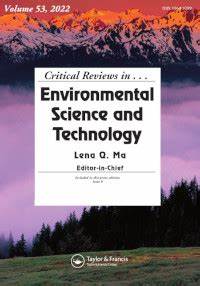Manganese oxides for electrochemical adsorption of metal ions in aqueous environments: A comprehensive review from fundamentals to applications
IF 13.2
1区 环境科学与生态学
Q1 ENVIRONMENTAL SCIENCES
Critical Reviews in Environmental Science and Technology
Pub Date : 2025-11-02
DOI:10.1080/10643389.2025.2557360
引用次数: 0
Abstract
The removal and recovery of metal ions from wastewater are crucial for environmental sustainability and resource management. Electrochemical adsorption emerges as a promising technology due to its simplicity, controllability, and eco-friendliness. Manganese oxides (Mn oxides), naturally abundant and electrochemically active, exhibit substantial adsorption capacities and selectivity for various metal ions in aqueous solutions, making them excellent candidates for this technology. This comprehensive review synthesizes the latest developments in Mn oxides-based electrochemical adsorption from fundamentals to applications. This review finds that the superior performance of Mn oxides stems from a synergy of multiple mechanisms. Beyond conventional electric double-layer adsorption, pseudocapacitive ion storage and surface redox reactions play a dominant role, offering a significant advantage in terms of both capacity and selectivity. The analysis reveals that this performance is intricately dependent on a delicate interplay between the material’s intrinsic properties (such as crystal structure, morphology, and average oxidation state), solution chemistry (including pH and the presence of co-existing ions), and operational parameters. Furthermore, this review provides a detailed overview of the diverse applications of Mn oxides electrodes, spanning not only wastewater treatment for heavy metals and radioactive ions but also crucial resource recovery endeavors such as seawater desalination, water softening, and lithium extraction. By offering a critical framework for understanding these complex mechanisms and identifying key influencing factors, this work provides a roadmap for the rational design of next-generation Mn oxides adsorbents and the future development of electrochemical metal ion recovery technologies.锰氧化物在水环境中电化学吸附金属离子:从基本原理到应用的综合综述
从废水中去除和回收金属离子对环境可持续性和资源管理至关重要。电化学吸附因其简单、可控性和生态友好性而成为一种很有前途的技术。锰氧化物(Mn氧化物)天然丰富且具有电化学活性,在水溶液中对各种金属离子表现出良好的吸附能力和选择性,使其成为该技术的优秀候选者。本文综述了锰氧化物基电化学吸附从基本原理到应用的最新进展。本文认为锰氧化物的优异性能是多种机制协同作用的结果。除了传统的双层电吸附外,假电容离子存储和表面氧化还原反应起着主导作用,在容量和选择性方面都具有显著的优势。分析表明,这种性能复杂地依赖于材料的内在特性(如晶体结构、形态和平均氧化态)、溶液化学(包括pH值和共存离子的存在)和操作参数之间的微妙相互作用。此外,本文还详细介绍了锰氧化物电极的各种应用,不仅包括重金属和放射性离子的废水处理,还包括海水淡化、水软化和锂提取等关键资源回收工作。通过为理解这些复杂的机制和确定关键影响因素提供关键框架,本研究为下一代锰氧化物吸附剂的合理设计和电化学金属离子回收技术的未来发展提供了路线图。
本文章由计算机程序翻译,如有差异,请以英文原文为准。
求助全文
约1分钟内获得全文
求助全文
来源期刊
CiteScore
27.30
自引率
1.60%
发文量
64
审稿时长
2 months
期刊介绍:
Two of the most pressing global challenges of our era involve understanding and addressing the multitude of environmental problems we face. In order to tackle them effectively, it is essential to devise logical strategies and methods for their control. Critical Reviews in Environmental Science and Technology serves as a valuable international platform for the comprehensive assessment of current knowledge across a wide range of environmental science topics.
Environmental science is a field that encompasses the intricate and fluid interactions between various scientific disciplines. These include earth and agricultural sciences, chemistry, biology, medicine, and engineering. Furthermore, new disciplines such as environmental toxicology and risk assessment have emerged in response to the increasing complexity of environmental challenges.
The purpose of Critical Reviews in Environmental Science and Technology is to provide a space for critical analysis and evaluation of existing knowledge in environmental science. By doing so, it encourages the advancement of our understanding and the development of effective solutions. This journal plays a crucial role in fostering international cooperation and collaboration in addressing the pressing environmental issues of our time.

 求助内容:
求助内容: 应助结果提醒方式:
应助结果提醒方式:


